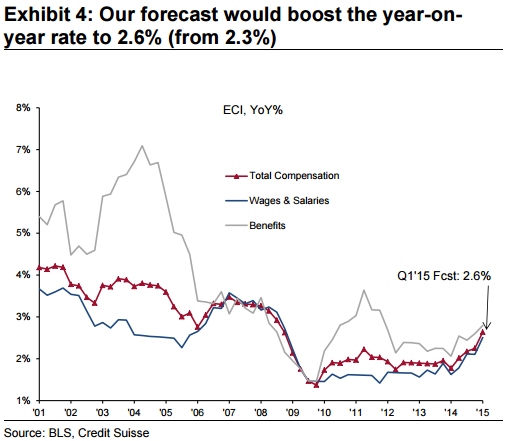What Wall Street will be watching this week
While first-quarter earnings, the situation in Greece and mergers and acquisitions have been the focus of attention lately, a fresh set of factors will be in play this week. These include the Federal Reserve policy announcement on Wednesday, April 29, the initial estimate of first-quarter GDP growth the same day and an update on wages and benefits on Thursday, April 30.
There's a common thread here: Expectations for the first Federal Reserve interest rate hike since 2006 have been pushed back into late 2015 or even early 2016 based on forecasts of a soft first-quarter GDP report (the Atlanta Fed's GDPNow estimate is at just 0.1 percent) and an annual inflation rate that remains below the Fed's 2 percent target.
But should the recent labor market tightening translate into wage inflation, as is widely expected, we should see GDP growth accelerate, inflation measures improve and the Fed regain the confidence it needs to start its first policy tightening campaign since 2004.
Central to this outlook will be Thursday's release of the latest Employment Cost Index data. Credit Suisse analysts favor this measure for insight into overall labor costs because it includes other forms of compensation besides hourly pay, such as commissions and benefits. Moreover, the measure isn't distorted by shifts in the mix of industries Americans are working in.
The analysts are looking for acceleration in total compensation to a 2.6 percent annual rate, which would represent a new high for the economic expansion to date. As the chart above shows, this would also bring compensation growth back to levels last seen before the worst of the financial crisis in late 2008.
For context, in the last two expansions this measure topped out near 4 percent -- so we've got some way to go yet before middle-class workers truly feel like the economy is firing on all cylinders and pumping money into their pockets.
As wages drift higher, broad measures of inflation should improve as well as aggregate demand surges in response to consumers getting their hands on extra cash. Wall Street, as you would expect, is already one step ahead.
The chart above from EPFR Global, a provider of fund flows and allocation data, shows that investors are moving to protect themselves from a rebound in inflation later this year. Daily inflows into the inflation protected bond funds tracked by EPFR that hold the U.S. Treasury's Inflation-Protected Securities have surged to a record high.
Moreover, we're in the midst of the longest run of strong inflows since the third quarter of 2012. U.S.-domiciled funds have attracted the most money so far this year in cash terms.
If these trends continue, the Fed could move to raise interest rates sooner than anticipated.


